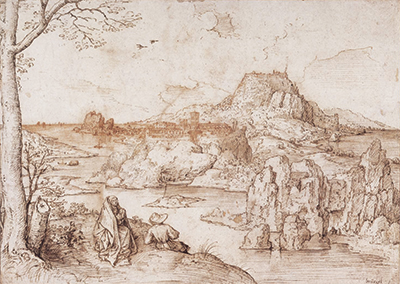Pieter Bruegel produced a detail drawing here which links closely to one of his most famous paintings, namely Landscape with the Flight into Egypt from 1563.
The two artworks are very similar in composition, with both including the key figures of the travelling party in the near foreground, looking out across a vast, stunning landscape. During this period there were no artists who specialised in landscape painting alone, with natural scenes always used as a support to something more important within the composition. Even centuries later a German artist made an entire career from this method of placing individual figures looking out over a large landscape, he was the extraordinaryily talented Caspar David Friedrich.
The techniques used in this drawing, probably pen and ink, allow the artist to really show the detail of the rocky elements of the landscape scene, particularly along the line of the twisting river. Despite the lack of colour one can still make out each and every element of the landscape and almost feel as if they are there themselves, perhaps sat alongside the figures nearest the viewer. Bruegel uses an age-old technique of laying an element vertically across the side of the canvas in order to frame the rest of the composition, in this case he chooses a tall tree which branches out across the top of the sketch.
Bruegel's drawings were spread far and wide across Europe into a variety of private collections before several institutions started to draw them in to their own collections. Two of the best are the Ashmolean Museum in Oxford, UK and also the Albertina in Austria with both offering a fine selection of drawings from the Renaissance and Baroque periods.




